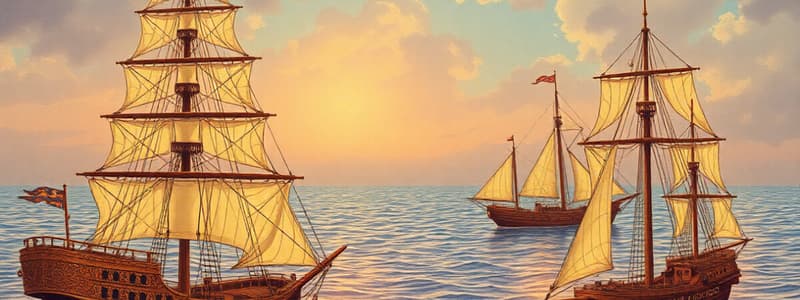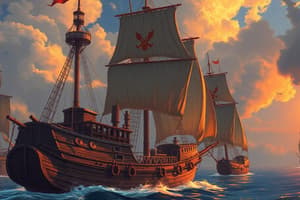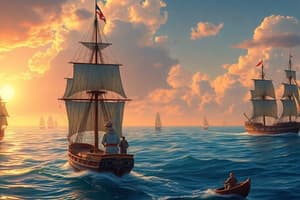Podcast
Questions and Answers
Which innovation was LEAST significant in facilitating the expansion of trade networks during the period 1450-1750?
Which innovation was LEAST significant in facilitating the expansion of trade networks during the period 1450-1750?
- The creation of joint-stock companies.
- Improvements in gunpowder technology. (correct)
- Development of new banking practices and credit systems.
- Advances in cartography and navigational instruments.
What was a primary motivation for European powers to establish maritime empires in the Indian Ocean during the period 1450-1750?
What was a primary motivation for European powers to establish maritime empires in the Indian Ocean during the period 1450-1750?
- To establish alliances with powerful Asian empires against rival European nations.
- To spread democratic ideals throughout the region.
- To discover new sources of precious metals and control trade routes. (correct)
- To find new lands for agricultural settlements due to overpopulation in Europe.
Which of the following describes a significant impact of the Columbian Exchange on the Americas?
Which of the following describes a significant impact of the Columbian Exchange on the Americas?
- Increased social equality as indigenous populations adopted European customs and governance.
- The introduction of new food crops and domesticated animals that transformed agricultural practices and diets. (correct)
- A rapid decline in the population of European settlers due to diseases from the Americas.
- A decrease in inter-tribal warfare due to the introduction of European weaponry.
Which statement accurately reflects a major difference between the Spanish and Portuguese colonial empires in the 16th and 17th centuries?
Which statement accurately reflects a major difference between the Spanish and Portuguese colonial empires in the 16th and 17th centuries?
What distinguished the Qing Dynasty's approach to foreign trade compared to the Ming Dynasty?
What distinguished the Qing Dynasty's approach to foreign trade compared to the Ming Dynasty?
Which factor contributed MOST to the rise of the Ottoman Empire in the 15th and 16th centuries?
Which factor contributed MOST to the rise of the Ottoman Empire in the 15th and 16th centuries?
Which of the following was NOT a significant cause of the Scientific Revolution in Europe?
Which of the following was NOT a significant cause of the Scientific Revolution in Europe?
Which of the following best describes the long-term impact of the Atlantic slave trade on West Africa?
Which of the following best describes the long-term impact of the Atlantic slave trade on West Africa?
Which accurately characterizes the role of mercantilism in European colonization during the 17th and 18th centuries?
Which accurately characterizes the role of mercantilism in European colonization during the 17th and 18th centuries?
Which describes a major consequence of the Seven Years' War (1756-1763)?
Which describes a major consequence of the Seven Years' War (1756-1763)?
How did the Enlightenment impact the Atlantic Revolutions?
How did the Enlightenment impact the Atlantic Revolutions?
What was a primary goal of the Congress of Vienna (1814-1815) following the Napoleonic Wars?
What was a primary goal of the Congress of Vienna (1814-1815) following the Napoleonic Wars?
Which describes a key difference between the Haitian Revolution and other revolutions in the Americas?
Which describes a key difference between the Haitian Revolution and other revolutions in the Americas?
What was one significant consequence of the Industrial Revolution on global migration patterns?
What was one significant consequence of the Industrial Revolution on global migration patterns?
Which of the following is an accurate comparison of the causes of the American and French Revolutions?
Which of the following is an accurate comparison of the causes of the American and French Revolutions?
Which statement best characterizes the relationship between nationalism and imperialism in the 19th century?
Which statement best characterizes the relationship between nationalism and imperialism in the 19th century?
In what way did the Taiping Rebellion (1850-1864) MOST challenge the authority of the Qing Dynasty?
In what way did the Taiping Rebellion (1850-1864) MOST challenge the authority of the Qing Dynasty?
Which of the following developments demonstrates the MOST significant degree of continuity with pre-1450 forms of economic organization in the period 1450-1750?
Which of the following developments demonstrates the MOST significant degree of continuity with pre-1450 forms of economic organization in the period 1450-1750?
Which of the following factors LEAST contributed to the rise of industrialization in Western Europe during the 18th and 19th centuries?
Which of the following factors LEAST contributed to the rise of industrialization in Western Europe during the 18th and 19th centuries?
Imagine an alternate historical timeline: a new, highly contagious and lethal airborne pathogen spreads rapidly across the globe during the early stages of transoceanic voyages (1450-1750), originating not in Eurasia but in the Americas, and disproportionately affects populations of Afro-Eurasia who lack immunity. Which of the following is the MOST likely long-term global consequence?
Imagine an alternate historical timeline: a new, highly contagious and lethal airborne pathogen spreads rapidly across the globe during the early stages of transoceanic voyages (1450-1750), originating not in Eurasia but in the Americas, and disproportionately affects populations of Afro-Eurasia who lack immunity. Which of the following is the MOST likely long-term global consequence?
Flashcards are hidden until you start studying




